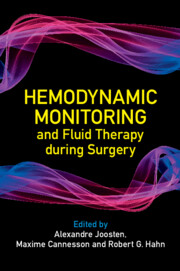Book contents
- Frontmatter
- Contents
- List of Contributors
- Foreword by Jean-Louis Vincent
- Preface
- Section 1 Hemodynamic Monitoring in the Perioperative Period
- Section 2 Basic Science & Concepts in Fluid Therapy
- Section 3 Practical Use
- 11 Outcome and Organ Dysfunction after Major Surgery
- 12 Perioperative Goal-Directed Hemodynamic Therapy
- 13 Fluid Responsiveness Assessment
- 14 Intra-Abdominal Surgery
- 15 Fluid and Hemodynamic Monitoring in Pulmonary Surgery
- 16 Fluid Management in Cardiac Surgery
- 17 Fluid and Hemodynamic Monitoring in Brain Surgery
- 18 Fluid and Hemodynamic Monitoring in Trauma
- 19 Fluid and Hemodynamic Monitoring in Pediatrics
- 20 Fluid Therapy for Liver and Renal Transplantation
- 21 Fluid and Hemodynamic Monitoring in Burns
- Section 4 Future Directions
- Index
17 - Fluid and Hemodynamic Monitoring in Brain Surgery
from Section 3 - Practical Use
Published online by Cambridge University Press: 11 April 2024
- Frontmatter
- Contents
- List of Contributors
- Foreword by Jean-Louis Vincent
- Preface
- Section 1 Hemodynamic Monitoring in the Perioperative Period
- Section 2 Basic Science & Concepts in Fluid Therapy
- Section 3 Practical Use
- 11 Outcome and Organ Dysfunction after Major Surgery
- 12 Perioperative Goal-Directed Hemodynamic Therapy
- 13 Fluid Responsiveness Assessment
- 14 Intra-Abdominal Surgery
- 15 Fluid and Hemodynamic Monitoring in Pulmonary Surgery
- 16 Fluid Management in Cardiac Surgery
- 17 Fluid and Hemodynamic Monitoring in Brain Surgery
- 18 Fluid and Hemodynamic Monitoring in Trauma
- 19 Fluid and Hemodynamic Monitoring in Pediatrics
- 20 Fluid Therapy for Liver and Renal Transplantation
- 21 Fluid and Hemodynamic Monitoring in Burns
- Section 4 Future Directions
- Index
Summary
Fluid administration is one of the basic components in the management of neurosurgical patients. However, there is still debate on the ideal fluid. Issues related to adequate volume replacement and effects on the intracranial pressure persist. Studies have demonstrated the harmful effects of colloids over crystalloids. Normal saline has remained a fluid of choice but there is now emerging evidence that it, too, is not free of its harmful effects. Hypertonic saline has also been accepted by many practitioners, but its use and administration require close monitoring. There is now growing evidence on the use of balanced solutions for neurosurgical patients. However, this evidence comes from a small number of studies. Hemodynamic monitoring for fluid therapy in these patients is prudent as these patients are prone to hypovolemia. Dynamic parameters like stroke volume variance and pulse pressure variance are considered more reliable to monitor fluid therapy in comparison to static parameters. This chapter briefly covers various clinical situations in neurosciences with respect to fluid therapy and use of hemodynamic monitoring while providing fluid therapy and its effect on patient outcome.
Keywords
- Type
- Chapter
- Information
- Hemodynamic Monitoring and Fluid Therapy during Surgery , pp. 200 - 207Publisher: Cambridge University PressPrint publication year: 2024

